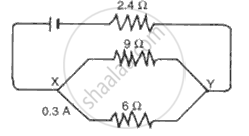Advertisements
Advertisements
प्रश्न
A current of 0.3 A is flowing through a branch of 6 Ω resistors in a junction as shown in fig. . Calculate the
(a) P.d. across the junction XY,
(b) Current flowing through 9Ω and 24Ω
( c) P.d. across 24 Ω resistor, and
( d) e.m.f. of the cell.

उत्तर
(a) Potential difference across XY = pot. cliff. across 6 Ω resistor
= 0.3 x 6=1.8V
b) Pot. difference across 9Ω resistor= pot. cliff. across 6 Ω resistor= 1.8 V
:. Current through 9Ω resistor = `1.8/9` = 0.2A
Current through 2.4Ω resistor = total current in the circuit = 0.3 + 0.2 = 0.5A
(c) p.d. across 2.4Ω resistor = 0.5 x 2.4 = 1.2 V
(d) emf of cell = p.d across 2.4Ω resistor+ pot cliff. across XY = 1.2 + 1.8 = 3.0 V
APPEARS IN
संबंधित प्रश्न
The work done in moving a unit charge across two points in an electric circuit is a measure of:
(a) current
(b) potential difference
(c) resistance
(d) power
The p.d. across a 3 Ω resistor is 6 V. The current flowing in the resistor will be:
(a) `1/2A`
(b) 1 A
(c) 2 A
(d) 6 A
How do you think the brightness of two lamps arranged in parallel compares with the brightness of two lamps arranged in series (both arrangements having one cell)?
A 3 pin mains plug is fitted to the lead for a 1 kW electric kettle to be used on a 250 V A.C. supply. Which of the following statements is NOT correct?
(a) A 13 A fuse is the most appropriate value to use.
(b) The brown wire should be connected to the live side of the mains.
Calculate the current through a 60 W lamp rated 250 V. If the line voltage falls to 200 V, how is power consumed by the bulb affected?
State expression for Cells connected in series.
Unit of electric power may also be expressed as
Electric current passes through a metallic conductor due to the movement of ______.
